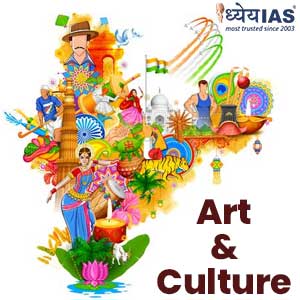(Video) Indian Art & Culture in English : Gupta Age : Temples and Sculpture
In the previous edition of art and culture we talked about the caves and the stupas of the Gupta period. In this part, we will talk about the temples and sculptures.
The Rock Cut Architecture reached its zenith during the Gupta period. This period marks the beginning of Indian temple architecture. Manuals concerned with the process of making temples were written. Most of the temples carved during this time were carved with the representation of Gods. Some prominent features like the shikhars, mandapa or the porticos, Sanctum Sanctorum- also known as Garbhagriha and vahana or the vehicle could be seen.
Talking about the temples, these can be categorised into five stages.
- The first – In this type buildings were in square shape with flat roof. Shallow pillared porticos. It comprised of a single entrance and porch. The best example of this is the temple no.17 at Sanchi.
- The second –it was an elaborate version of the first stage. These were two storied temples. The passageway was covered and the platforms were raised high. The Important addition in this stage was the covered passageway around the sanctum.
- The third – Shikhars made their appearance instead of the flat roof. Panchayatan style of temple making was introduced. Dasavatara temple (Deogarh, Jhansi)
- The fourth - Very similar to the previous stage, only difference or development was in case of the main shrine. It became more rectangular.
- The fifth- The rest of the similar features were there except the introduction of circular temples with shallow rectangular projections. Example – Maniyar math Rajgir Bihar.
Two broad orders of temples in the country are known— Nagara in the north and Dravida in the south.
In the Nagara Style, the whole temple is built on a stone platform with stairs leading to it. There were no grand boundary walls or gateways.
Based on the shape of shikhars, Nagara style has three variation- Valabhi type, Rekha Prasad or Latina and Phamsana.
Valabhi comprised of rectangular buildings with a roof that rises into a vaulted chamber. Also called as wagon-vaulted buildings.
Rekha Prasad comprised of simple shikhara with square base and whose walls slope inwards to a point on top. Most common type.
Phamsana in many North Indian temples was used for mandapa. Roofs were made of several slabs that rose to a single point over the centre of the building. These building were broader and short.
The Nagara style/ school was sub divided into three schools –
Odisha School – Within this, the Shikhara is vertical almost to the top and suddenly curves sharply inwards. These are preceded by mandapas. The ground plan is always square but becomes circular in the crowning mastaka. Exterior are lavishly carved. Example- Konark TEMPLE, Jagannath Temple.
Khajuraho School – The shikhara is curved and miniature shikhara appear from the central tower. The halls and porticos of the temple are also crowned with smaller towers.
Solanki School – The amazing feature of this style is its minute decorativeness.
The major examples of Gupta temple architecture are the temples – Dasavatara temple of Deogarh, Bhitargaon temple, Vishnu Temple of Jabalpur, Shiva Temple of Bhumara, Parvati Temple of Nachria Kathura, Mukund Darra Temple of Kota, Lakshaman Temple of Raipur, Shiva Temple of Koh and Bhitari Temple at Ghazipur.
Now we will talk about the sculptures of Gupta period.
The Gupta period sculptures depict dignity. During this period Indian sculpture entered into its classic phase.
The Buddha images at Sarnath reflect serenity and contentment. The Hindu gods of the Gupta period were primarily incarnations of Vishnu.
Represented by a red sand-stone, figure of a standing Buddha with an immense decorated hallow is seen.
A great example of Gupta sculpture created at Sarnath is that of the seated Buddha preaching the Law, carved of Chunar sandstone. This was a new school i.e. the Sarnath School of sculpture.
A remarkable piece of Gupta metal-casting found at Sultanganj in Bihar is nearly 7 feet high. Another metal figure but of a smaller size in bronze was found in U.P.
Buddha images in Sarnath have plain transparent drapery covering both shoulders.
The art of Barhut, Amravati, Sanchi and Mathura came closer melting into one. The great artistic creations of the period were invested with sweet and soft contours, restrained ornamentation and dignified repose. Under the patronage of the Guptas, the studies of Mathura and Sarnath produced several works of great merit.
The magnificent red sandstone image of the Buddha from Mathura is a most remarkable example of Gupta workmanship datable to the 5th century A.D. The great Master, shown standing with his right hand in abhayamudra, assuring protection, and the left holding the hem of the garment. The robe covering both shoulders is skilfully represented with delicately covered schematic folds and clings to the body. The head is covered with spiral curls.
The stone carving from the temples at Deogarh and those from the temples of Udayagiri and Ajanta are excellent specimens of figure sculpture in their decorative setting.
A magnificent representation of Vishnu belongs to the Gupta period, and comes from Mathura. The typical gown, thevanamala; the charming string of pearls twirled round the neck, the long and elegant yagnopavita are all characteristic of early Gupta work.
The Head of Shiva is an elegant example of Gupta terracotta’s, depicted with matted locks, tied in a prominent and graceful top knot.
With time the sculpture quality deteriorated. It became heavier and started to be made of metal.







